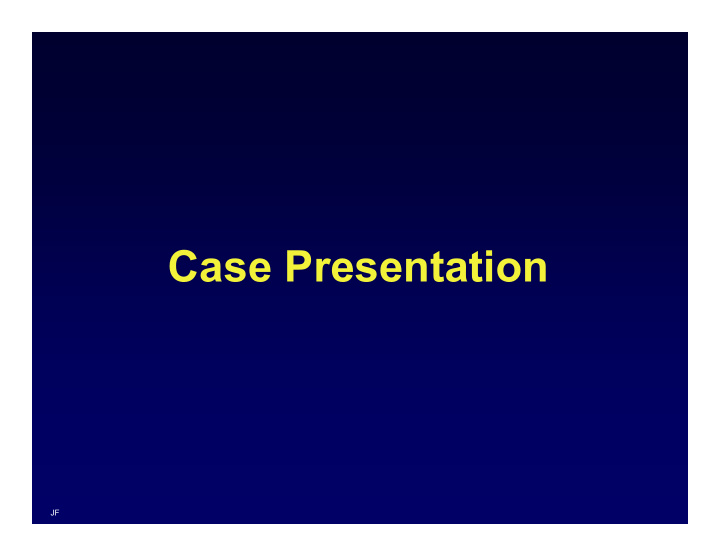



Case Presentation JF
History, P/E and relevant labs Male 85 yo, HIV Dx 1996 (CD4-550, HIV-RNA 5000) referred for care 1999 PHx: syphilis, 50 pack-yr cigarettes Meds: none MSM, single, unemployed, previous multiple partners P/E tall & robust, BMI 25.6 HIV-RNA – 100,000 copies; CD4- 420 (15%), CD8- 76%, CD4/8 - 0.20 (N>1.0) Fasting lipids: TC – 4.9 mmol/L, TG – 2.19, HDL - 0.8, LDL – 3.15, TC/HDL – 6.1 HBV - immune, HCV - negative, VDRL - neg JF
Summary of initial status Clinically well Moderate immunosuppresion High nadir CD4 but increased HIV-RNA and low CD4/CD8 ratio Mild hypertriglyceridemia, low HDL c/w inflammatory dyslipidemia JF
Course 1999 Nelfinavir plus Combivir 2001 CMB plus Kaletra: VL < 50, CD4-550 2002 ED, low free testosterone, Rx w andriol & viagra DXA-normal LS & FN BMD, Fat Mass Ratio 1.8 (N) 2004 EMG-mild peripheral neuropathy 2006 syphilis; CMB plus ATV/r, jaundice, change to SQV/r plus CMB; DLP (Rx w atorvastatin 10 mg) FRS- 20% (high), WC-103 cm ( = high risk for CVD) 2008 (Dx elsewhere, delay in notification) extrasystoles Echo- EF 40%, mild LV dysfunction- no Rx JF
Course 2010 abdominal pain, CT – infrarenal AAA (5x4 cm) Cardiac - echo 25% EF Cath- 20-30% obstruction c/w non-ischemic cardiomyopathy ( HIV, AZT) Multiple diuretics + beta-blockers, low BP, AF (CHADS 3) coumadin, ICD inserted LGI bleed, C & G scope negative KLT monotherapy (high CPE), CD4-700 2011 f/u echo- EF 40% JF
Course 2013 increased TGs, RAL/KVX 2014 uncomplicated AAA repair Meds (non-HIV): tamsulosin, finasteride, furosemide, atorvastatin, apixaban, vitamin D, pantoprazole Concern from friend about driving (lives off- island) and poor self-care ( occ incontinent) MOCA-25/30, home visit from community clinic x1 then no f/u JF
Course 2015 CD4-800, Weight 97 kg, BMI 31 waist circumference 105 cm GFR > 60, postural hypotension (no falls), back pain (lumbar DDD), slow gait, using cane & wheelchair (convenient) still driving 2016 No c/o, says ok for ADL/IADL concern re short-term memory decline, MOCA-16 new iron def anemia, several months to arrange C-scope (negative), G-scope- ??, transfusion Sept 2016- formal driving assessment arranged bathroom aids installed, friend supervising meals, limited community support JF
Active issues HIV: stable but low CD4/CD8 c/w persistent immunosuppression and immunosenescence (IRP) 2 clinical periods: -1999-2010 HIV management - > 2010 comorbidities JF
Summary of status Co-morbidities : arrythmia, dilated cardiomyopathy, post- op, anemia nyd, metabolic syndrome (abdominal obesity [WC> 102] + incr TG + low HDL), spine DDD, cognitive decline Multimorbidity (> 2 co-morbidities) Geriatric syndromes : frailty (Fried criteria ≥ 3 of slowness, weakness, low activity , exhaution, wt loss); increased risk of falls (NB use of NOAC); polypharmacy (2 ARVs, 6 others and 1 vitamin); social isolation; impaired functional status; cognitive decline Cognitive decline risks : age; abdominal obesity; low cardiac output; vascular (AF); ART; HAND JF
Question: What issues typical of older HIV patients does this person exhibit? JF
Factors affecting this patient’s QOL Functional decline Physical dependence Decreased economic capacity Change in social activity Relationship with others JF
Frailty Heterogenous syndrome common in the elderly Decreased physiologic reserve, increases vulnerability to negative outcomes including loss of independence, requirement for supervised housing, increased morbidity and mortality Characterized by low endurance, poor strength, impaired balance, and low physical activity JF
Objective definition of frailty* as proposed by Fried et al Morley JE et al. The Aging Male 2005;8(3/4):135-40 JF
JF
Spectrum of neurocognitive disorders in HIV infection Normal Asymptomatic neurocognitive impairment (ANI) Mild neurocognitive decline (MND) HIV-associated dementia (HAD) JF
Proportion of HIV pts with neurocognitive impairment according to HAND criteria Dulioust A et al. CROI ‘09 JF
Risk factors for cognitive decline in HIV patients Specific (HIV-related) Common (increased risk or occurring earlier) Nadir CD4 Increasing age Minimal CD4 increase on HAART (possibly) low education : limited reserve HIV subtypes (increased risk with D) Vascular risks: increased risk of High serum/CSF viral load HPB and increased rates of cigarette smoking Controversial: HAART with poor CSF penetration Lipids : increased cholesterol, (possibly) low HDL (strategic) treatment interruptions Chronic inflammatory state Diabetes – HIV infection Genetic predisposition (Apo-E4 – possible role of GI tract immune homozygous) system as an HIV reservoir HCV JF
Alternative classification of dementia: Alzheimer disease (AD) and vascular dementia (VaD) fall on a continuous spectrum of disease Viswanathan A et al. Neurol 2009;72:368-74 JF
Treatment outcomes: older pts often have lower pre-HAART and plateau CD4’s but similar HIV-RNA post-HAART ( suggesting delayed Dx and better adherance ) Median log 10 (HIV- RNA) evolution Median CD4 + T cell count/mm 3 evolution ! Nogueras M et al. BMC Inf Dis 2006;6:159 JF
HIV, Immunosenescence and Clinical Outcomes Serrano-Villar et al. HIV Med 2013 JF
What about long-term effects of TFV in aging HIV patients? Bone demineralization Renal toxicity Role of TAF JF
Recommend
More recommend